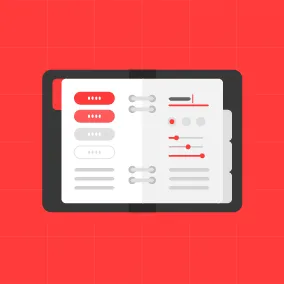Design Systems: Problems & Solutions

Tom Osborne, Former VP, Design
Article Categories:
Posted on
Wondering why you might need a Design System? Do these problems sound familiar? Here's how they help.
Why do you need a Design System?
In a previous article, we shared our thoughts on why Design Systems may be on the rise. Now, let’s further explore why you might need one. What are some of the common problems organizations face without a Design System, and how can one help?
Common Problems
Here are a few warning signs that might indicate you need to think about implementing a Design System:
Process bottlenecks
Through agile development methodologies, rapid release cycles have improved the ability for organizations to make timely and recurring updates. This means that individuals in organizations have had to do things more quickly than they used to. The benefits of speed often come at a cost. Usually, that cost is a compromise in quality. How will you ensure quality without introducing bottlenecks to your release cycles?
Design inconsistencies
Because your design needs have had to keep up with your development cycle, you’re left with a mess. Things as simple as having a dozen different versions of a button that could be simplified down to a few—component management. Maybe you have five different versions of a similar color or twelve different font styles when you could be using four—style management. Perhaps you’ve built a check-out flow that works differently in different places creating a nightmare for your customer support team—operational management. How will you establish and maintain consistency?
Scaling challenges
Perhaps you’ve focused on one platform when you first designed but are now scaling to multiple platforms. Maybe you started as a native application and are now working towards a web-based application or vice versa. It’s possible you didn’t think about how your designs would adapt to varying screen sizes or across platforms. How will you introduce new platforms?
How can a Design System help? What problems do they solve?
Now that you’ve explored some of the reasons you might need one, let’s look at how Design Systems can help.
Centralized knowledge base
By creating and maintaining a Design System, you’ll have a centralized reference point to account for the most up-to-date standards. This resource should be easy for anyone on the company to find, comprehend quickly, and put to use. It’s the place where you find guidelines and resources. It should be updated in harmony with your evolving needs.
Cross-platform consistency
As you expand your digital footprint across varying platforms from web to native applications or from smart watches to giant displays or from voice-activated devices to extended reality (XR), you’ll be able to better align and account for design consistency. Cross-platform consistency and brand consistency are synonymous.
Less excess
Let’s face it, the more inconsistency there is with your design, the more inconsistency there will be with your underlying code. With every different version of page elements or templates, there’s a higher likelihood of unnecessary code loading to render the design elements. This means design cruft and technical debt go hand-in-hand. By minimizing unnecessary excess, you’ll be better optimized for usability while gaining performance benefits through faster rendering of content.
Increased efficiency
The less you have to start from scratch every time you start a new design, the more efficient you will be in being able to design, build, and launch things quickly. Also worth mentioning, it will be far faster and easier to get approvals if your designs are aligned with existing standards.
Not sure where to begin?
These are just a few of the reasons you might consider implementing a Design System. In our next article, we’ll explore where to begin and why you might hire an agency (like Viget) to help with your needs.